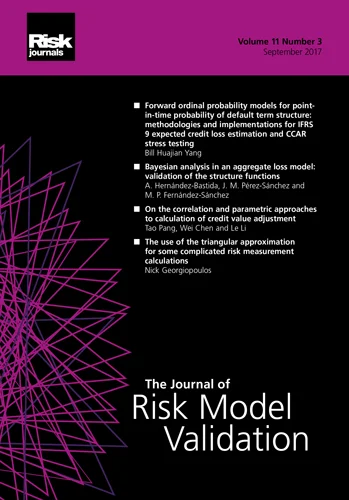Journal of Investment Strategies
ISSN:
2047-1238 (print)
2047-1246 (online)
Editor-in-chief: Ali Hirsa
Volume 13, Number 2 (June 2024)
Editor's Letter
Ali Hirsa
Professor, Columbia University & Managing Partner, Sauma Capital LLC
Welcome to the second issue of the thirteenth volume of The Journal of Investment Strategies, which contains three research papers.
In the first paper in the issue, “Formulations to select assets for constructing sparse index tracking portfolios”, Yutaka Sakurai, Daiki Wakabayashi and Fumio Ishizaki study methods of constructing sparse index tracking portfolios, which offer several advantages over full replication portfolios in finance and investment management. They propose formulations for asset selection, described as combinatorial optimization problems, which can be adjusted using various parameters to yield a range of asset selection methods (including existing ones, such as market capitalization top-tier selection and correlation balance selection). By adjusting these various parameters, the authors’ formulations allow for a balanced and effective selection of assets that results in a successful sparse index tracking portfolio. Sakurai et al also introduce a multistage selection method, in which assets are selected multiple times with varying centrality and dissimilarity parameters. Applying these methods to construct tracking portfolios for the Tokyo Stock Price Index (TOPIX) and the Standard & Poor’s 500 (S&P 500), the authors demonstrate through numerical examples that their formulations can outperform traditional selection methods in tracking performance, highlighting the flexibility and efficacy of their approach.
In the issue’s second paper, “Delving into the investment psyche: investigating the determinants influencing individual investors’ decision-making”, Rajesh Raut, Harsha Thorve, Amruta Deshpande and Natasha Kaul explore behavioral finance by examining key cognitive biases that influence individual investment decisions. They identify herding, overconfidence and mental accounting as the most significant, with overconfidence being the most critical. Through a quantitative analysis of data from 400 investors, their study measures five cognitive biases using 12 variables, and their findings provide insights for both investors and portfolio managers: key behaviors include herding, where investors follow their peers; regret bias, where missed opportunities affect emotions; mental accounting, where investors hold on to small gains despite previous larger ones; and overconfidence, where investors believe they can outperform the market. The study emphasizes the need for increased investor awareness of these biases and their impact on decision-making. The implications extend beyond individual investors, offering guidance to financial advisors, analysts and policy makers. Advisors can use these insights to provide more personalized advice, while policy makers can use them to develop better regulations to protect investors. In addition, Raut et al’s research could also assist financial service providers in designing products that account for these biases, thereby improving investment outcomes. Their findings can also help refine behavioral finance models and inform educational programs aimed at boosting financial literacy. Further research could explore other biases, incorporate neuroeconomics and utilize game theory and probabilistic logic to enhance understanding of investment behavior. This study makes a valuable contribution to a somewhat sparse literature, and it underscores the need for further exploration of neurological biases and their intersection with behavioral economics to refine investment decision-making models. The editorial board and I welcome further contributions on this topic.
Our third and final paper, “Unaligned exchange traded funds: risk-adjusted performance and market-timing skills” by D. K. Malhotra and Philip Russel, examines the performance of specialty unaligned exchange traded funds (UETFs) in comparison with US and global equities between February 2000 and April 2023. Their analysis reveals a significant positive correlation between UETFs’ average monthly returns and those of US and global equities; UETFs consistently demonstrated superior absolute performance, surpassing the average monthly returns of both US and global stocks throughout the sample period. A risk-adjusted analysis for this period shows that UETFs again outperformed their US and global counterparts, generating positive alpha; rolling monthly alphas calculated over successive intervals underscore UETFs’ sustained outperformance relative to global equities. Despite their name, UETFs are not immune to stock market fluctuations and remain vulnerable to broader market volatility. However, Malhotra and Russel highlight that UETFs have shown resilience during economic crises (including the Covid-19 lockdowns), further demonstrating their outperformance relative to global equities. The paper delivers extensive insights into UETFs’ performance dynamics in relation to broader equity markets.
The editorial board and I extend our gratitude to you, our valued readers, for your unwavering support and interest in our journal. We are excited to present a growing collection of practical papers on diverse topics relating to modern investment strategies, sourced from both academic and industry experts.
Papers in this issue
Formulations to select assets for constructing sparse index tracking portfolios
The authors put forward methods to chose assets for sparse index tracking portfolios and demonstrate the tracking performance with numerical examples.
Delving into the investment psyche: investigating the determinants influencing individual investors’ decision-making
The authors investigate five cognitive biases and how they impact investment decisions, using data from 400 investors to determine which factors are significant factors in the making of investment decisions.
Unaligned exchange traded funds: risk-adjusted performance and market-timing skills
The authors compare the performance of unaligned exchange-traded funds with US and global equities, finding a significant positive correlation in monthly returns.








